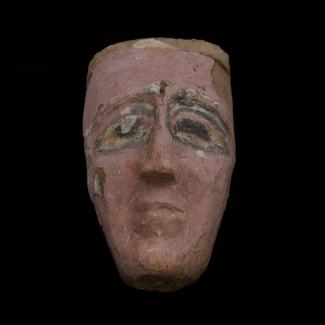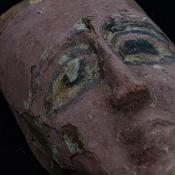The mask is carved with a painted pink face and white and black eyes. The eyebrows are also painted black. The head has been sawn off above the brow and below the chin, where it would have originally fitted into the fittings for an authentic sarcophagus.
The piece is solid wood, with the back of head sawed flat. Four diagonal holes for wooden pegs have been drilled about 1/4" to 3/8" in diameter at points on the back.
This mask used to be mounted on sarcophagus in Ancient Egypt as an image of the person who was entombed in the specific site. Each of the diagonal holes in the back functioned to attach the mask to the surface of the sarcophagus. This was used mainly as a funerary piece with the practice originating in Pre-Dynastic Egypt (c. 3100 BCE and earlier) and ending at the close of the Ptolemaic Period (c. 30 BCE). The quality of the mask indicates that it was most likely carved for an individual of modest social and economic standing. More famous sarcophagus "death masks" include the solid gold mask of Pharaoh Tutankhamun, which is representative of the high social and economic status that the rulers of Ancient Egypt once wielded. The wooden construction of this particular mask and the level of paint deterioration indicates that it may have been carved for a lesser priest, craftsman, or bureaucrat within the society of the New Kingdom. The subject was likely an ethnic Lower Egyptian, as outsiders oftentimes were not of high enough status to merit a sarcophagus mask.


